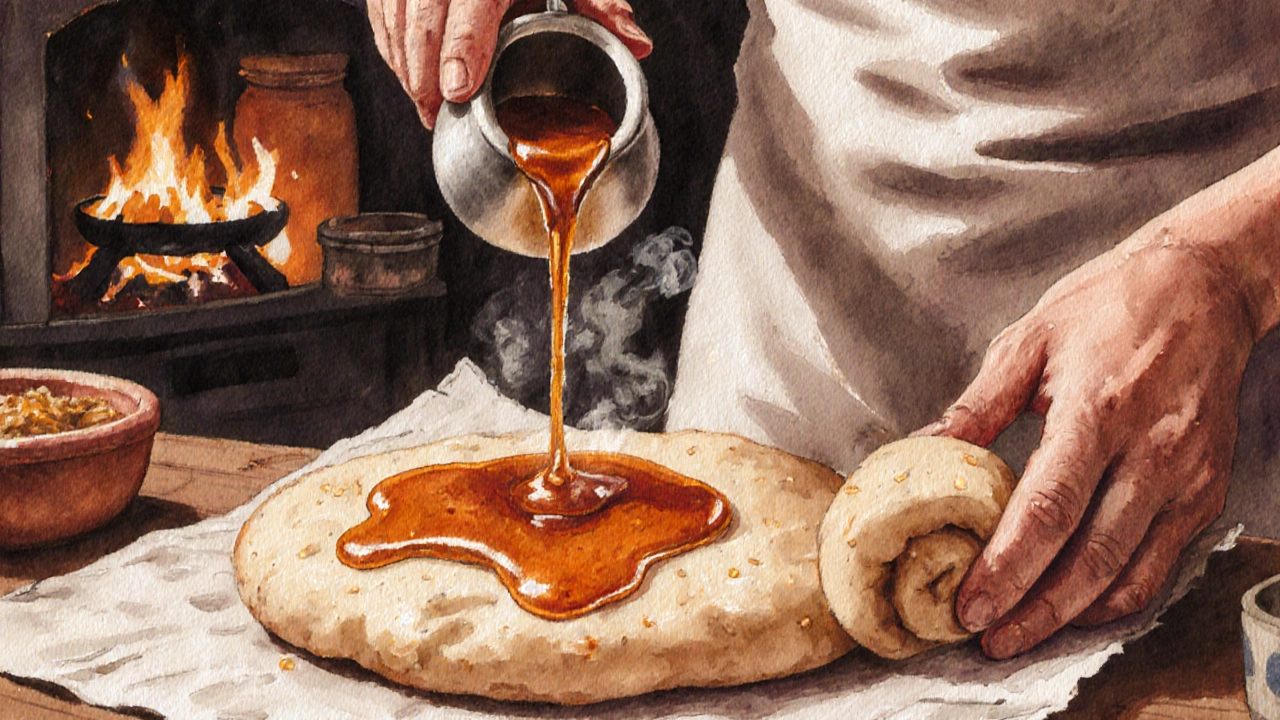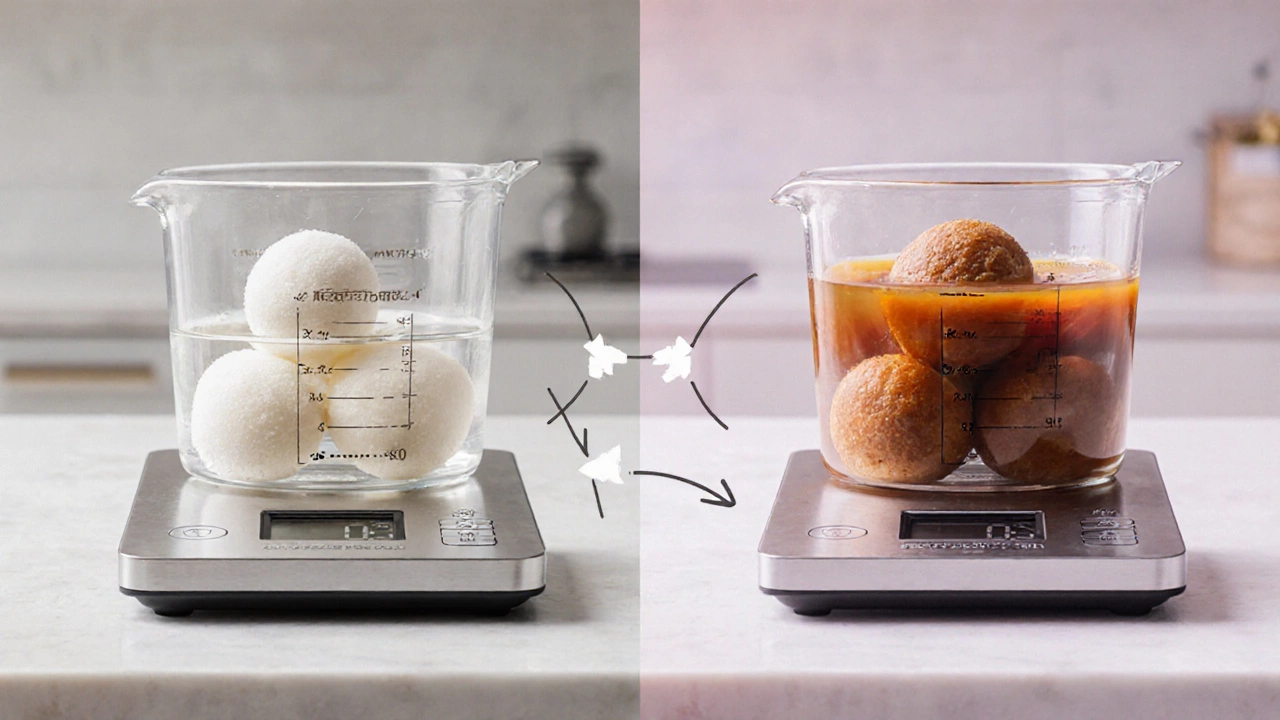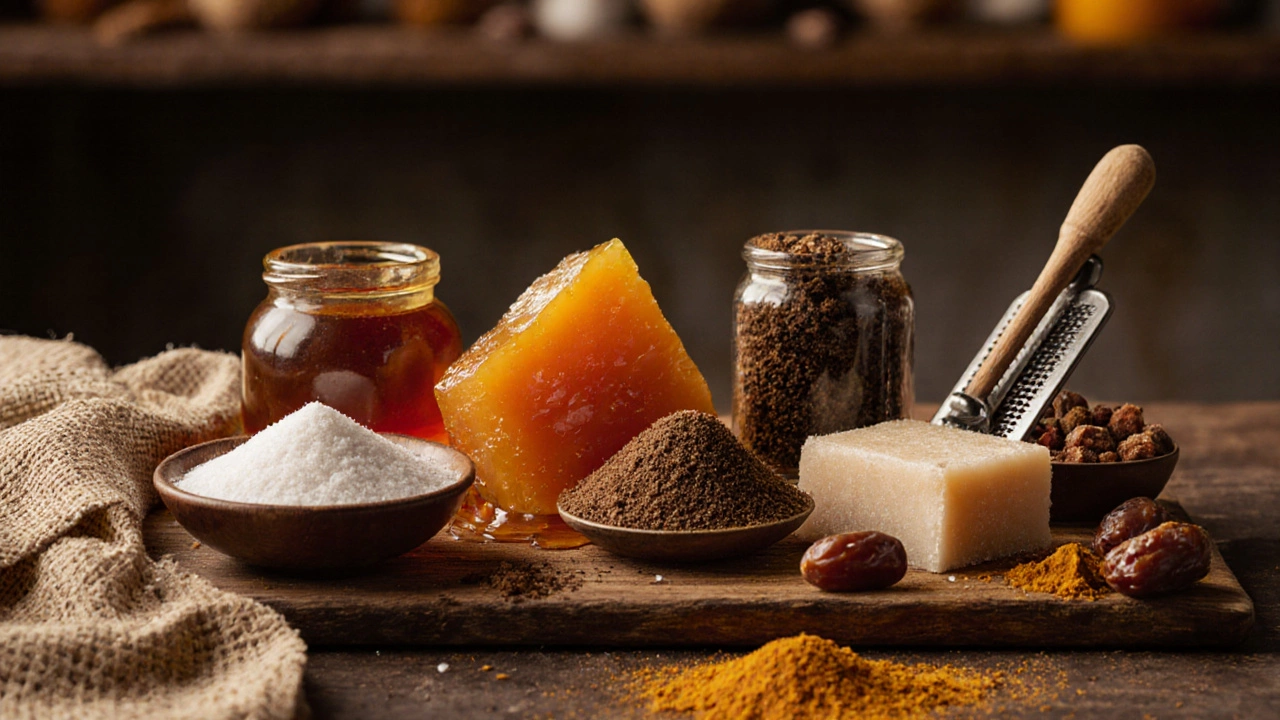Sweetener Substitution Calculator
Indian Sweetener Substitution Calculator
Calculate how much of any Indian sweetener to use as a substitute for white sugar in your recipes.
Equivalent Sweetener Amount
Adjustments Needed
When it comes to Indian sweetener any sugar‑like ingredient that gives Indian desserts their characteristic sweetness, the answer isn’t just “white sugar.” From golden‑brown jaggery to fragrant honey, each sweetener shapes the flavor, texture, and cultural story of a sweet. Below we break down the most popular sweeteners, why cooks choose them, and how to swap them without ruining a classic treat.
Why Indian sweets need more than one sweetener
Indian cuisine spans dozens of regions, each with its own climate, crops, and religious practices. That diversity translates into a pantry full of alternatives to refined sugar. Some sweeteners add moisture, others contribute caramel notes, while a few bring a hint of spice. Knowing the role each plays lets you pick the right one for gulab jamun, kheer, or payasam without a trial‑and‑error marathon.
1. Cane Sugar (Granulated White Sugar)
Granulated white sugar is the most widely available sweetener in Indian households. It’s refined from sugarcane or beet, stripped of molasses, and leaves a neutral sweetness that doesn’t mask other flavors. Classic recipes such as rasgulla and besan laddu rely on white sugar because it dissolves quickly in syrup and doesn’t alter the texture of the base.
2. Jaggery (Gur) - The Golden Traditional Sweetener
Jaggery an unrefined concentrated sugar made by boiling sugarcane juice or palm sap has been the backbone of Indian sweets for centuries. Its deep amber color and caramel‑like flavor make it ideal for dishes like puran poli, chikkis, and tilgul. Jaggery also contains trace minerals such as iron and potassium, which is why many traditional families consider it a healthier option than white sugar.
3. Brown Sugar - Moisture‑Rich Substitute
Brown sugar is simply white sugar with a coating of molasses. It brings a mild, buttery note and extra moisture, which can be useful in bhurji‑style sweets like khaja or in the syrup for rasmalai. Because it retains some molasses, it dissolves slower than white sugar, so a brief simmer is recommended.
4. Honey - Floral Sweetness from the Hive
Honey a natural syrup produced by bees from flower nectar offers a distinct floral aroma that works wonders in lighter desserts such as shrikhand or as a glaze for barfi. Its high fructose content means it stays sweet even when heated, but it can brown quickly, so low‑heat cooking is advisable.

5. Coconut Sugar - Low‑Glycemic Alternative
Coconut sugar a sweetener derived from the sap of coconut palm flower buds has a mild caramel flavor similar to jaggery but a lower glycemic index. It’s gaining popularity in health‑focused versions of malpua and thandai. Because it granulates like brown sugar, it can replace sugar cup‑for‑cup, though the color will darken the final dish.
6. Palm Sugar - The Southeast Asian Cousin
In the coastal regions of Kerala and the northeastern states, Palm sugar a sweetener made from the sap of palm trees such as date or toddy palm is common. It imparts a rich, earthy sweetness that pairs well with coconut milk in desserts like palan polo and cherupayar payasam. Palm sugar crayons are often sold in solid blocks that need to be grated before use.
7. Date Sugar - Natural Crystallized Dates
Made by drying and grinding dates, Date sugar a low‑glycemic sweetener that retains the fiber of whole dates adds a subtle fruity note. It’s excellent in nut‑based sweets like badam halwa where the extra texture is a plus. Since it doesn’t melt, it’s best used in dry mixes or sprinkled on top.
8. Artificial Sweeteners - When Calories Matter
Low‑calorie options such as sucralose or stevia are occasionally used in diet‑friendly versions of traditional sweets. They provide sweetness without the sugars, but they can introduce a slight aftertaste and may affect the setting of milk‑based desserts. Use them sparingly and test a small batch before scaling up.
How to Choose the Right Sweetener for Your Recipe
- Flavor match: If you want caramel depth, reach for jaggery or coconut sugar.
- Moisture needs: Brown sugar and honey add extra liquid, which helps softer textures.
- Health considerations: Date sugar and palm sugar offer lower glycemic spikes.
- Cooking method: For high‑heat frying (e.g., jalebi), stick with white sugar or jaggery that can withstand caramelization.
- Availability: In many urban markets, white sugar is the only guaranteed ingredient, so recipes often default to it.

Practical Tips for Swapping Sweeteners
- Measure by weight, not volume, when switching to jaggery or palm sugar. Their density differs from white sugar.
- If a recipe calls for syrup, dissolve the alternative sweetener in a little warm water first to avoid grainy textures.
- Because jaggery and brown sugar contain molasses, reduce added liquids by about 10 % to keep consistency.
- When using honey, cut the amount by ¼ cup for each cup of sugar and add a pinch of extra baking soda if the batter needs leavening.
- For date sugar, blend it into a fine powder to mimic the mouthfeel of regular sugar.
Common Mistakes and How to Avoid Them
Many home cooks assume they can simply replace white sugar with any other sweetener, but the results often fall flat. Over‑cooking jaggery can make it bitter, while using too much honey can cause excessive browning. Always taste the syrup before adding the base, and remember that some sweeteners, like coconut sugar, darken the final color, which may affect presentation.
Comparison of Popular Indian Sweeteners
| Sweetener | Sweetness Level (vs. white sugar) | Typical Flavor Notes | Common Desserts | Pros | Cons |
|---|---|---|---|---|---|
| White Sugar | 1.0 | Neutral | Rasgulla, Besan Laddu | Easy to dissolve, consistent | Low mineral content |
| Jaggery (Gur) | 0.9 | Caramel, earthy | Puran Poli, Chikki | Contains iron, authentic taste | Grainy if not melted properly |
| Brown Sugar | 0.95 | Molasses, buttery | Khaja, Rasmalai syrup | Adds moisture | Can darken color |
| Honey | 1.2 | Floral, light | Shrikhand glaze, Barfi | Natural, antibacterial | Browns fast, strong flavor |
| Coconut Sugar | 0.75 | Caramel, nutty | Malpua, Thandai | Lower GI, vegan | Gets gritty if not fine |
| Palm Sugar | 0.8 | Earthy, deep | Palan Polo, Cherupayar Payasam | Traditional, distinct aroma | Hard to find outside region |
| Date Sugar | 0.7 | Fruity, mild | Badam Halwa, Energy bites | High fiber, low GI | Doesn’t melt, grainy texture |
Quick Takeaways
- White sugar stays neutral; jaggery adds caramel depth and minerals.
- Honey provides floral notes but can brown fast; use low heat.
- Coconut and palm sugars are lower‑glycemic choices with earthy flavors.
- When swapping, adjust liquid ratios and watch for color changes.
- Measure by weight for consistency, especially with dense sweeteners.
Frequently Asked Questions
Can I use jaggery instead of white sugar in any sweet?
Jaggery works best in recipes that benefit from its caramel note, such as puran poli or chikki. In delicate milk‑based sweets where a clear syrup is essential, like rasgulla, white sugar is still preferable because jaggery can introduce cloudiness.
Is coconut sugar healthier than regular sugar?
Coconut sugar has a lower glycemic index (about 35 vs. 65 for white sugar) and retains some nutrients from the coconut palm sap. However, it’s still mostly sucrose, so moderation is key.
How do I prevent honey from crystallizing in my syrup?
Add a tiny pinch of lemon juice or cream of tartar while heating. The acid interferes with sugar crystals forming, keeping the syrup smooth.
Can I mix two sweeteners in one recipe?
Yes. Combining jaggery with a touch of white sugar balances depth and sweetness in sweets like shrikhand. Just keep the total sweetness level in mind and adjust other ingredients accordingly.
Is it safe to use artificial sweeteners in traditional Indian sweets?
They’re safe in moderation, but the texture can change. For milk‑based desserts, the lack of caramelization may result in a thinner consistency. Test a small batch before serving a larger crowd.
What’s the best way to store jaggery to keep it fresh?
Keep jaggery in an airtight container in a cool, dry place. If you live in a humid climate, wrap it in a muslin cloth before sealing to absorb moisture.
Armed with this sweetener guide, you can experiment confidently, honor tradition, and still keep an eye on health. Whether you’re making a festive laddu or a simple kheer, the right sweetener makes all the difference.
